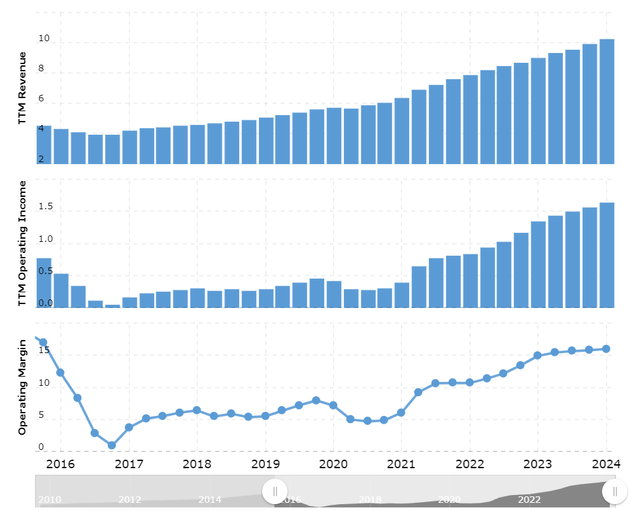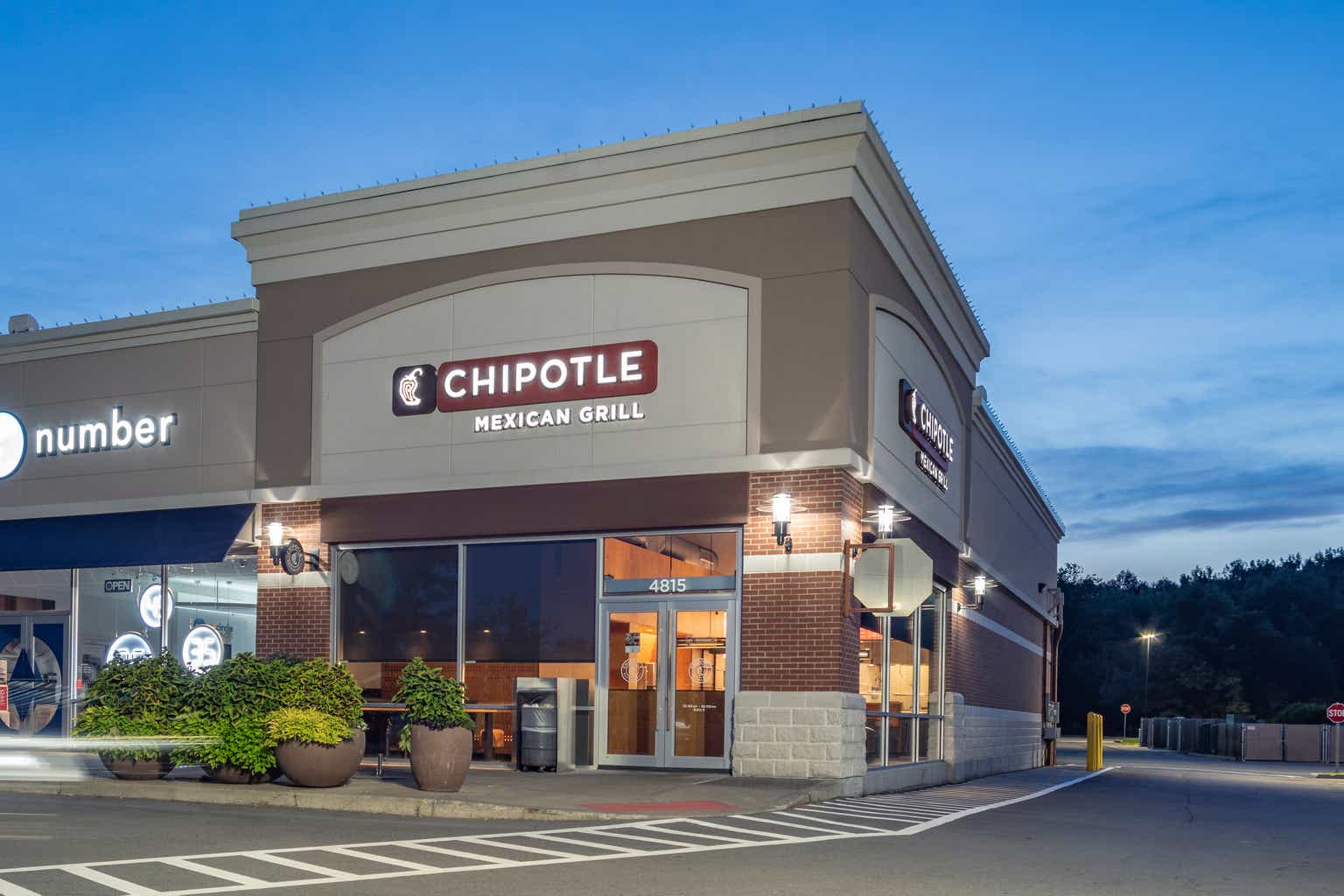Introduction & Investment Thesis
Chipotle Mexican Grill (NYSE:NYSE:CMG) operates restaurants that serve burritos, burrito bowls, quesadillas, tacos, and salads using fresh, high-quality ingredients, and its stock has outperformed the S&P 500 and Nasdaq 100 YTD. The company reported its Q1 FY24 earnings on April 24th, where revenue and operating income grew 14.1% and 20% YoY, respectively, driven by the strength in transaction volume and size from improved throughput, relevant brand campaigns, and menu innovations, as comparable restaurant sales grew 7.0% YoY along with 47 new restaurant locations with 43 locations that include a Chipotlane, bringing the total restaurant count to 3479.
Although the management increased their outlook for comparable sales to grow in the mid to high single digits, they also warned of potentially higher costs of sales from input materials, such as avocados, as well as wage price inflation, which can hurt short-term margins. Although the company has thus far successfully passed on the costs over to the consumer without dampening their growth prospects, I believe that a weakening labor market and uncertain macroeconomic landscape increase the risk of a pullback in consumer spending, which can hurt Chipotle’s top and bottom lines. Plus, investor optimism is at elevated levels given projections of future earnings growth, which I believe increases the vulnerability of a sizable short-term price correction. Assessing both the “good” and the “bad,” I believe that short-term valuation risks have outgrown, relative to upside potential, making it a “sell” at current levels.
The good: Strong Q1 revenue driven by growth in transaction volume and size, Improving throughput and menu innovations boosting customer engagement, Improving unit economics
Chipotle reported its Q1 FY24 earnings where revenue grew 14.1% YoY to $2.7B, driven by strength in comparable restaurant sales growing 7% YoY, coupled with opening 47 new restaurants and 43 Chipotlanes, as the company saw improvement in throughput in their restaurants, while scaling awareness from successful marketing campaigns and menu innovations by spotlighting Barbacoa and the return of Chicken Al Pastor as a limited time offer.
Macrotrends: Improving revenue and operating margin
During the earnings call, Brian Niccol highlighted some of the key strategies that are helping them win in a tough macroeconomic environment, where they continue to experience strong foot traffic leading to 19% YoY growth in in-store sales as well as growing their presence digitally, with digital sales representing 37% of sales in Q1. In this post, I will discuss three of the company’s core strategies that it is using to engage and retain their customers in order to assess the long-term investment thesis of the company.
The first strategy that I would like to discuss is the company’s focus on running successful restaurants by serving great food and delivering superior in-restaurant and digital experiences for the customer. While the company takes great pride in preparing healthy and delicious foods with the highest standards, it also emphasizes its throughout, which continued to improve by nearly two entrees in 15 minutes compared to last year, as it spends resources on better training the teams, allowing them to keep up with demand without stress. I believe that the speed of service at restaurants plays a crucial role in driving an improved guest experience, and as the company continues to improve its throughput, it will benefit from higher transaction volume as well as lower turnover, while customers’ wait times reduce, allowing them to get hotter and fresher foods faster.
The second strategy that I would like to talk about is their go-to-market programs to build engaging and relevant brand campaigns and menu innovations. Apart from their continued success with the Behind the Foil brand campaign, which shows their teams preparing fresh food by hand that they ran across all media channels, including the NFL playoffs, they also started promoting their Braised beef barbacoa by emphasizing the culinary recipe, which successfully drove incremental transactions and spend. Simultaneously, they also brought back Chicken Al Pastor, which was one of the most requested new menu items, thus ensuring that its brand engages their customers with relevant food experiences alongside seamless execution. Simultaneously, I also like that the company is also leveraging its digital reach of 40M rewards members to drive targeted promotions in order to increase frequency of purchase and spend while successfully driving new enrollments at the same time.
The final strategy that I would like to bring your attention to is the company’s culture of improving productivity by investing in technology and innovation, which includes their automated digital make line and Autocado, which they will be rolling out in restaurants on the black half of the year. I believe that these technologies will improve consistency, especially at high-volume restaurants, thus paving the way for throughout to further improve, boosting customer engagement and transaction volume.
Shifting gears to profitability, the company spent 28.8% of their revenue on food, beverage, and packaging costs that decreased 40 basis points from the previous year. This was primarily driven by menu price increases from October 2023 as a result of higher food price inflation for items such as beef and produce. Simultaneously, their labor costs also decreased 20 basis points YoY to 24.4%, which was made possible by unlocking sales leverage from higher transaction volume and spend per customer, thus offsetting wage inflation. Meanwhile, the company generated an operating income of $441M on a GAAP basis, which grew 20% YoY at a margin of 16.3% as the company benefited from improving unit economics by driving higher transaction volume and purchase order sizes, coupled with lower delivery expenses and marketing costs.
The bad: Food price volatility and wage inflation can squeeze margins if consumer spending slows.
Although the company has increased their annual comparable restaurant sales growth estimates in the mid to high single digits, there was certain management commentary in the earnings call that made me concerned about the overall profitability picture in the short term. During the earnings call, the management indicated that they may see higher prices across several of their input materials, most notably avocados, coupled with wage inflation stepping up to about 6% as a result of minimum wage increases in California. So far, the company has been able to successfully pass on the incremental costs over to the consumers in the form of higher menu prices without taking a hit on their top-line, as consumer demand has remained resilient given a strong labor market and stable financial conditions. However, the landscape may change in the coming quarters, where they may not be able to pass on the costs to consumers if food price volatility and wage inflation continue to remain elevated. This will be the case if we see a deterioration in the overall macroeconomic conditions where customers will likely slow down their frequency of visits and size of purchases from Chipotle, given weakness in labor market conditions.
At the same time, although the company is seeing success with expanding internationally across the Middle East, Europe, and Canada, with Canada leading the company in key operational metrics including throughput, there are uncertainties associated with replicating similar growth stories in every international market, which could give rise to an increase in marketing spend and other operating expenses, while simultaneously squeezing overall margins.
Tying it together: Chipotle is overvalued at current levels.
Looking forward, I will take the consensus estimates for revenue and earnings growth over the next 3 years to come up with a fair value for Chipotle. Therefore, assuming that revenue grows in the low to mid teens over the next 3 years, which I believe is achievable as the company continues to improve its throughput through training and technology investments, coupled with engaging their customers with relevant brand campaigns and menu innovations, while expanding internationally, it should generate $14.37B in revenue by FY27.
From a profitability standpoint, taking the consensus estimates for non-GAAP EPS of $79.12 in FY27, we see that it will be growing at a faster rate than overall revenue growth, which I believe will be possible as the company improves its unit economics during this period of time, absent any major spike in food price and wage inflation. This will be equivalent to a present value of $65.39 in EPS when discounted at 10%.
Seeking Alpha: Consensus Estimates for EPS
Taking the S&P 500 as a proxy, where its companies grow their earnings on average by 8% over a 10-year period with a price-to-earnings ratio of 15-18, I believe that Chipotle should be trading at roughly 2x the multiple given the growth rate of its earnings during this period of time. This will translate to a PE ratio of 35, which is lower than its current estimated forward PE of 40, or a price target of $2288, which represents a downside of 27% from its current levels.
Author’s Valuation Model
Similar to my previous article on Wingstop (NASDAQ:WING), I believe that Chipotle has operated very well in driving consumer demand at a time when it had to raise its menu prices from inflation in an uncertain macroeconomic environment. Fundamentally, I believe that the company is positioned to drive continued growth in the future where it focuses on delivering elevated in-store and digital customer experience in the US and internationally, while improving throughput at the same time to increase transaction volume and size as it delivers healthy and delicious meals prepared with the highest standards. However, I believe that consumer spending will likely decelerate from current levels, especially if the labor market weakens, along with a potentially volatile environment for food and wage price inflation that can hurt short-term margins. Assessing both the “good” and the “bad,” I believe that investor optimism is elevated at current levels, leaving the stock vulnerable to a short-term pullback, making it a “sell.”
Conclusions
Although I am impressed by the company’s execution thus far, I will not be initiating a position at its current levels and will be waiting on the sidelines for a better entry point. Till then, I will rate the stock a “sell” at its current levels.
Read the full article here


